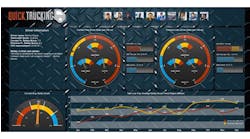Last week the Wall Street Journal reported that economists were expressing doubt about China’s recently surging export numbers, citing both the slow growth in the economies of many countries that usually source from China and the rise in the value of the yuan. Have the export numbers been inflated by companies hoping to further goose the yuan’s value and therefore juice-up their own profit margins?
I bring this up because not long after I read this article we received an e-mail from Panjiva, a service that monitors global trade activity at the company level, letting us know that it is launching a new service to make Chinese trade data more accessible and searchable. They’re doing this by partnering with another service called Export To China (ETCN). The goal is to make information on more than 200,000 companies importing to/exporting from China available within the context of Panjiva’s broader data sets. Panjiva asked if we had any questions about this service.
Timing is everything, right?
So I asked Panjiva’s CEO Josh Green whether China might be fudging its trade numbers to make exports look stronger than they really are, and how its new service would address that. He said it’s always a challenge for supply chain managers to sort the macro numbers from the granular analysis they need to do when analyzing target markets and potential sourcing partners.
“If you’re trying to find patio furniture suppliers you want to figure out which companies have the most experience shipping patio furniture, possibly serving the European market,” he explained. “Or if a Chinese company approaches you about doing business with them and you want to get a sense of their size and specialties and markets they’ve served previously, those are questions we could answer. We’re not about providing an aggregated view of global trade.”
There’s been speculation for years that the macro numbers economists follow have been subject to manipulation for political purposes. That’s particularly the case with China, but you can’t deny that this country’s huge and growing middle class represents big opportunities for manufacturers around the world who want a piece of that market. The question is, do you serve it from your home country or set up shop in China? Or someplace close to China? And where will you source from? You can’t make those decisions by relying on economic analysts—unless that analyst is you.
Green suggests you adopt a two-level decision making process. Identifying a country is step one, and it includes studying that country’s politics, wage rates and infrastructures. Step two is the company-level analysis.
“Simply saying I want to source patio furniture in China is fine but you have to find a company and people you feel confident will supply you with what you need,” Green concluded. “Looking at things from a macro level is for economic strategists, but on a day-to-day basis, for buying and selling things, you have to get down to the company level.”
Yes, maybe many companies in China have fudged their numbers, but many haven’t—and you’ll find examples of both all over the world. As you screen your global supply chain partners while figuring out where China fits in your chain, it may be advantageous to diversify manufacturing sources, both inside China and outside.
China’s consumers have a way to go before their country’s import numbers start getting economists as excited as they’ve been about exports. As Michael Zakkour, principal of the China/APAC Group at Tompkins International noted in MH&L’s March issue, the pace at which China is transitioning to a majority consumer and services economy isn’t fast enough to keep the country from trying to do something to send the right signals—and to keep its people employed.
“China still needs an export economy as well as manufacturing for its domestic needs,” he wrote. “After the 2008 financial meltdown, demand from the West plummeted, millions of Chinese workers were on the streets and the Central Government got very nervous. The nearly 1 trillion dollar stimulus in China in 2009 put people back to work on infrastructure and in manufacturing. The Chinese government has sufficient will and cash to subsidize manufacturing until consumers and services reach their potential for at least the next ten years.”
So whether or not China is reengineering its export numbers for global consumption, it’s clear it will do what it can to keep its industries competitive. The numbers you need will be found inside those industries. Making sure they add up is a supply chain manager's job, not an economist’s.


